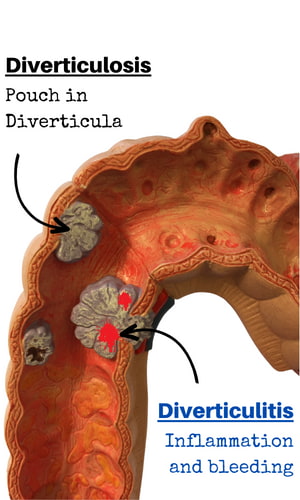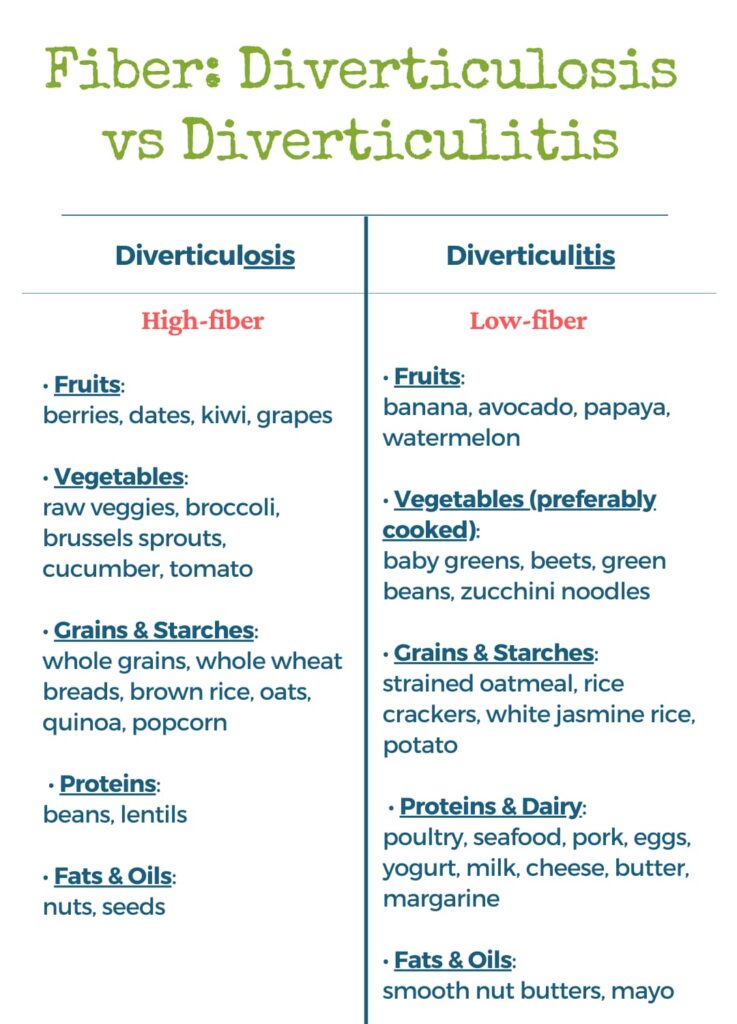Diverticulitis Diet PDF [Free Download]
“Diverticulitis Diet PDF” was written by Balbina Herrera & edited/reviewed by Aly Bouzek, MS, RDN. Balbina is a dietetic intern at Larkin University.
The diverticulitis diet is recommended for individuals experiencing diverticulitis symptoms, pain, or inflammation. It also plays a significant role in preventing the progression of diverticulitis.
To find what works best for you, make sure to speak with your doctor and dietitian.
Intro: Diverticulitis Basics
It’s important to understand what factors lead to diverticulitis to help us better understand the diverticulitis diagnosis as a whole.
In this article, we are going to learn more about diverticulitis, the diverticulitis diet, and how they compare to diverticulosis and the diverticulosis diet.
Jump to the diverticulitis diet PDF section and don’t forget to snag your FREE Diverticulitis Diet PDF. Here we go!
Diverticulosis Can Lead to Diverticulitis

Diverticulosis occurs in the large intestine (colon) and occurs when there is presence of small pouches (diverticula) in the intestine.
The formation of these pouches is associated with a lack of fiber in the diet.
Diverticulosis doesn’t produce any symptoms, so your doctor would need to recommend a colonoscopy to confirm the presence of diverticulosis.
When the small pouches in the intestines are inflamed or infected, diverticulosis transforms into diverticulitis.
Diverticulitis also occurs in the large intestine and occurs when inflammation or infection is present in one or more diverticula.
Symptoms of diverticulitis are more serious and might require intensive care if not treated in time.
Diverticulitis can be acute or chronic and can cause chronic symptoms, bleeding, complications, as well as other health problems that could arise.
Diverticulitis Risk Factors
There is no one specific cause of diverticulitis. However, there are several uncontrollable and controllable risk factors that play a key role in its development.
These include, but are not limited to (1):
Uncontrollable:
- Age: risk of diverticulitis increases with age (2)
- Genetics
- Sex
Controllable:
- Physical activity: staying active with high activity exercises (i.e. more than a stroll around the block) may help in reducing the risk of diverticulitis (3)
- Obesity: a BMI of >30 increases the risk of diverticulitis (4)
- Eating and drinking
- Certain drugs and/or medications
Symptoms of Diverticulitis
Possible signs of diverticulitis include but are not limited to:
- Abdominal bloating
- Pain
- Diarrhea
- Chills
- Fever and chills
- Cramps
- Constipation
- Nausea and vomiting
Fiber & Diverticulitis Risk
Fiber is a nutrient that helps to keep your digestive system healthy by slowing down your food’s travel time through your digestive tract. There are two types of fiber: soluble and insoluble.
Soluble fiber helps to slow digestion and is found in foods like:
- Whole fruits
- Root vegetables
- Seeds and nuts
- Beans, peas, legumes
Insoluble fiber helps to push food through our digestive tract more efficiently. It is found in foods like:
- Fruits and green vegetables
- Whole grains
- Nuts and seeds
- Potatoes with skin on
The role of fiber in the diet and how it affects diverticulitis risk has been a gray area for quite some time. So, which is better: a diet rich in fiber or a diet low in fiber? Let’s find out!
Diverticulitis Risk
A study published in 2019, that included more than 50,000 participants who had no diverticulitis diagnoses, found that a high insoluble fiber diet was associated with the lowest risk of diverticulitis when compared to a low fiber diet. (5)
Currently, the American Gastroenterological Association recommends a high-fiber diet for those with a history of acute diverticulitis.
It should be noted, however, that recommended consumption of a high-fiber diet may depend on your medical history. Please speak with your doctor and a dietitian to create a specific diet for you.
Diverticulosis Diet vs. Diverticulitis Diet
Now that we’ve talked about a few of the differences between diverticulosis and diverticulitis, let’s look at the differences between the two diets. Remember, we are focusing on fiber. A diverticulosis diet is high in fiber. A diverticulitis diet is low in fiber.

Diverticulosis Diet
It is important to consume a high fiber diet as a preventative approach, as diverticulosis can lead to diverticulitis. This means choosing more legumes, vegetables, fruits, and nuts for your meals and snacks.
Since constipation can bring about diverticula, a high fiber diet is recommended to help soften stools and move food through your digestive tract more easily.
With food moving more easily through your digestive tract, there is less pressure against the diverticula (small pouches) and less chance of diverticulitis flares.
An example day following a diverticulosis diet may look like:
Total fiber: 39 gm
Breakfast: 9 gm fiber
AM Snack: 6 gm fiber
Lunch: 10 gm fiber
PM Snack: 3 gm fiber
Dinner: 11 gm fiber
Breakfast: Oatmeal
- ½ cup oats
- 1 Tbsp chia seeds
- ½ cup 2% milk
- 2 Tbsp peanut butter
AM Snack: Berries + Nuts
- 1 cup strawberries
- 1 ounce almonds
Lunch: Salmon + Quinoa + Veggies
- 3 oz grilled salmon
- 1 Tbsp olive oil
- Pinch of salt + pepper
- 1 cup cooked quinoa
- ½ cup Brussels sprouts
- 1 cup broccoli
PM Snack: Kiwi + Cottage cheese
- 1 kiwi
- ½ cup cottage cheese, 1% fat
Dinner: Lentil salad
- ½ cup cooked lentils
- 2 Tbsp olive oil
- 1 cup spinach
- ½ cup cauliflower
- 2 dates
- 1 lemon
- 1 Tbsp sunflower seeds

Diverticulitis Diet PDF
If you are experiencing a diverticulitis flare, then a low fiber diet (or even a clear liquid diet) will likely be recommended by your doctor. This is because your diverticula are inflamed or infected, and they need time to rest.
Following a low fiber diet helps to reduce bulk and amount of stool.
Don’t forget to download your FREE diverticulitis diet PDF!
We recommend the following when adapting a diet for diverticulitis:
- Follow a low-fiber diet (no more than 10–15 grams of fiber per day)
- Eventually, start incorporating more fiber slowly
- Avoid food that is difficult to digest (or as instructed by your doctor)
- Raw vegetables
- Spicy food
- Dairy products
- Consuming small frequent meals throughout the day
An example day on a diverticulitis diet may look like:
Total fiber: 14 gm
Breakfast: 4 gm fiber
AM Snack: 2 gm fiber
Lunch: 3 gm fiber
PM Snack: 2 gm fiber
Dinner: 3 gm fiber
Breakfast: Eggs + Avocado toast
- 2 eggs, cooked
- 1 Tbsp olive oil
- 1 slice sourdough bread
- ¼ avocado
AM Snack: Greek yogurt + Banana
- 1 cup Greek yogurt, plain, low fat
- 1 medium banana
Lunch: Grilled chicken with rice + Zucchini noodles
- 3 oz grilled chicken breast, skinless
- 1 Tbsp olive oil
- ½ cup steamed white rice
- 2 cups well-cooked spiralized zucchini
- 1 Tbsp pesto
PM Snack: Rice cake + Nut butter + Apple juice
- 1 rice cake
- 2 Tbsp smooth peanut butter = 1.5
- 1 cup apple juice
Dinner: Fish + Potato
- 3 oz baked salmon
- 1 Tbsp olive oil
- ½ cooked potato, no skin
- 1 Tbsp butter

Diverticulitis Diet PDF Conclusion
A diet for diverticulitis is often recommended for individuals who are experiencing symptoms of diverticulitis, with the aim to reduce inflammation and help prevent the progression of the disease.
While the diet may seem restrictive, sticking to it, per doctor’s orders, can lead to positive results. Once you start feeling better, you will be able to gradually increase your fiber intake and eat a wider variety of foods.
